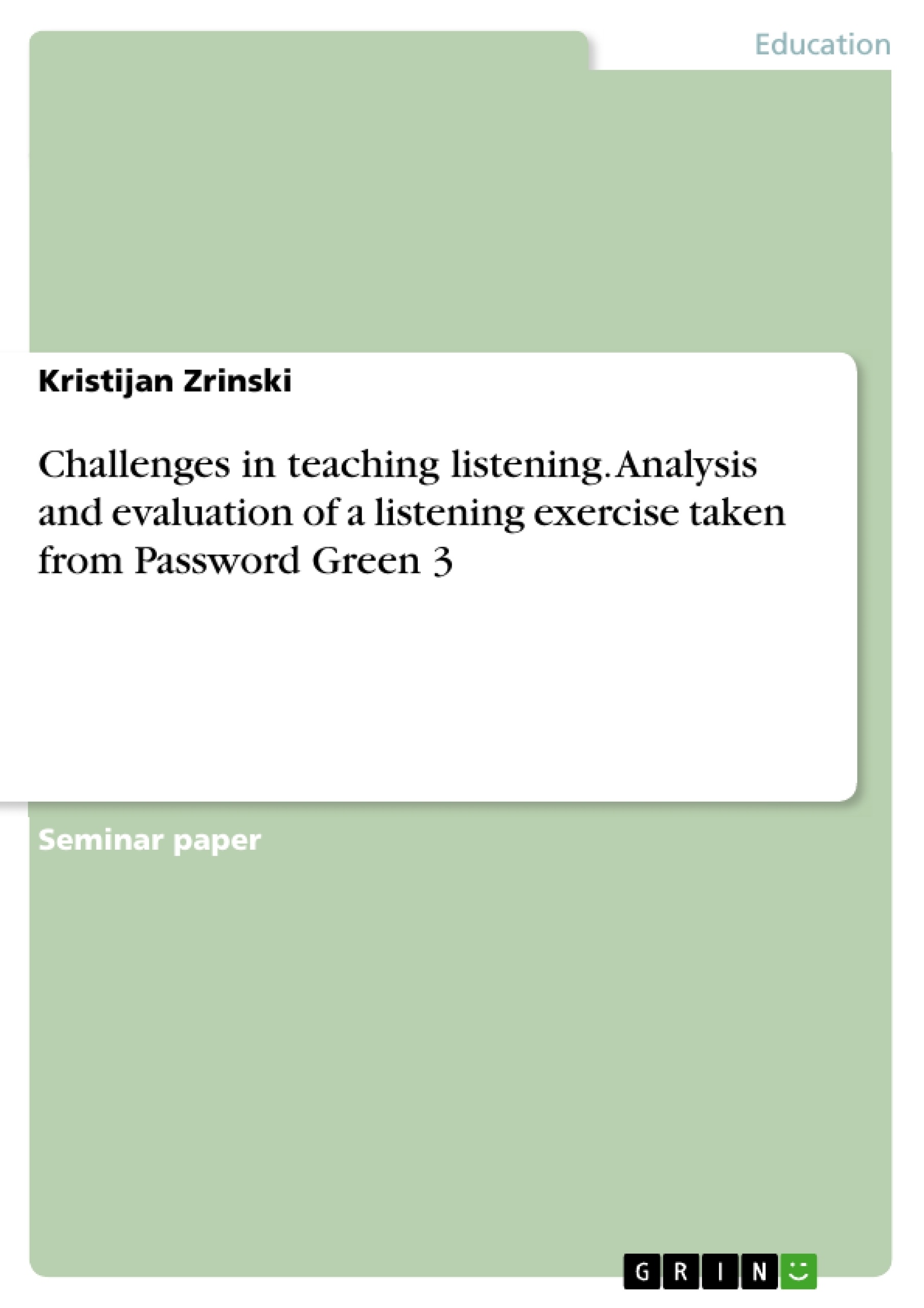This paper deals primarily with the analysis and the evaluation of a listening exercise taken from a textbook series called Password Green. Password Green 3 is an English textbook for students in Germany who attend the seventh grade of a Gymnasium (i.e. secondary school). Further, the theory of listening (comprehension) (as provided by: Andreas Müller-Hartmann and Marita Schocker-v. Ditfurth (Introduction to English Language Teaching) and the educational magazine Der Fremdsprachliche Unterricht Englisch: Hörverstehen) as well as the Syllabus (Lehrplan English Sekundarstufe I / Gymnaisum) and the Educational Standards (Bildugnsstandards erste Fremdsprache Mittlerer Schulabschluss) will be taken into consideration. With the help of these stated sources the practical example will be analysed. Moreover, the term paper aims to illustrate to what extent the exercise applies to the theory and the requirements of Educational Standards and Curriculum. Additionally, the evaluation from a teacher´s perspective will discuss under which conditions the exercise may be used or what risks and chances the analysed task can entail. It is important to mention that this term paper lays focus on my own opinion towards the analysed practical example and therefore does not reflect the opinion of any of the authors found in the list of secondary sources.
Inhaltsverzeichnis (Table of Contents)
- Introduction
- The Theory of Listening
- Textbook: Password Green 3
- Strategy Page: Listening
- Practical Example
- Conclusion and Evaluation
Zielsetzung und Themenschwerpunkte (Objectives and Key Themes)
This paper examines a listening exercise taken from the textbook series Password Green 3, designed for seventh grade students in Germany. It aims to analyze the exercise in relation to the theory of listening comprehension, educational standards, and curriculum requirements. The paper evaluates the exercise from a teacher's perspective, considering its strengths, weaknesses, and potential impact on student learning.- Analysis of listening comprehension theory and practice
- Evaluation of the listening exercise in light of educational standards
- Exploration of the role of listening strategies in language learning
- Discussion of the importance of understanding versus memorizing in listening tasks
- Recommendations for improving listening comprehension instruction
Zusammenfassung der Kapitel (Chapter Summaries)
Introduction
This section introduces the topic of the paper, which is the analysis and evaluation of a listening exercise from the Password Green 3 textbook series. The author outlines the scope of the paper, which includes examining the theory of listening comprehension, educational standards, and the curriculum requirements for seventh grade English language learners in Germany.The Theory of Listening
This section provides an overview of the theory of listening comprehension, highlighting the importance of both bottom-up and top-down processing. It emphasizes the active nature of listening and the need for learners to develop both linguistic and non-linguistic knowledge to construct meaning from what they hear.Textbook: Password Green 3
This section introduces the textbook Password Green 3 and its focus on British and American culture and language. It also highlights the inclusion of Strategy Pages in each unit, which aim to teach specific skills such as listening, writing, and reading. The author expresses her support for the Strategy Pages as a valuable addition to the textbook and teaching materials.Strategy Page: Listening
This section examines the Strategy Page for listening comprehension, which offers tips, suggestions, listening activities, and questions to improve students' listening and speaking skills. It discusses the importance of teaching different listening strategies and making students aware of the varying learning objectives of different listening exercises.Practical Example
This section analyzes the practical example provided on the Strategy Page, which involves three telephone conversations between patients and a receptionist at a doctor's surgery. The author describes the exercise's content, structure, and how it aligns with educational standards. She discusses the importance of understanding the context of the conversations and highlights the role of script theory in comprehending familiar situations.Conclusion and Evaluation
This section provides a concluding evaluation of the listening exercise, highlighting its strengths and weaknesses. The author praises the exercise's alignment with educational standards and theory, but also suggests potential areas for improvement, such as incorporating more challenging tasks and ensuring that students go beyond simply memorizing information. She emphasizes the importance of teachers providing clear guidance, support, and a positive learning environment for developing listening comprehension skills.Schlüsselwörter (Keywords)
This paper focuses on the challenges and complexities of teaching listening comprehension, specifically within the context of the seventh grade English language curriculum in Germany. Key concepts include: listening comprehension theory, educational standards, curriculum requirements, listening strategies, bottom-up processing, top-down processing, script theory, intercultural understanding, and the importance of active learning versus passive memorization.- Arbeit zitieren
- Kristijan Zrinski (Autor:in), 2012, Challenges in teaching listening. Analysis and evaluation of a listening exercise taken from Password Green 3, München, GRIN Verlag, https://www.grin.com/document/229423



